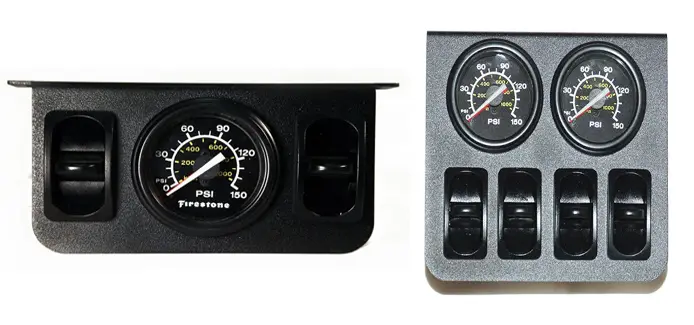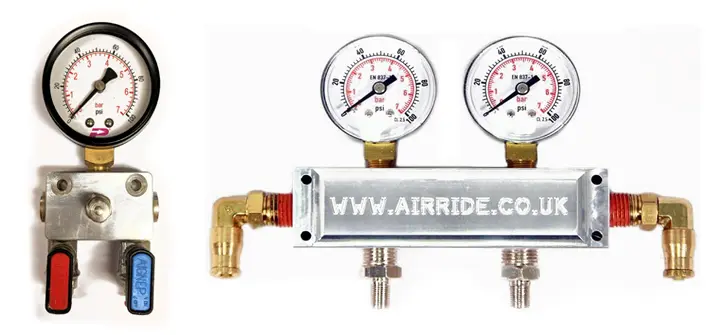Please note:
Motorhome owners with basic air suspension often call us to ask how to properly operate their air suspension. These notes are about getting started with most of the commonly-available systems. Since they are based upon never having seen your particular motorhome or conversion, they are intended for guidance only. If in any doubt take the vehicle to a motorhome specialist for inspection.
Safety First!
Don not under any circumstances work under a vehicle without adequate levels of support. Never trust any air suspension system to stay inflated whilst you are under it. Unsafe working practices with any suspension can result in very serious injury or death. Air suspension has additional concerns and procedures which must be adhered to – they have additional dangers of injury or death.
The first thing to do before putting air in the system is to carry out a visual inspection of the air bag – particularly if you have just bought a vehicle or it has been standing for a while. If the bag is perished (has small cracks to the rubber) it will need to be replaced. Safe working practice is to replace bags in pairs. The first place to start is the original manufacturer or installer if they still exist. During our time in the air suspension business almost none of the original manufacturers still exist. If you need replacement parts and the manufacturer does not exist please do get in contact.
What is a load support kit?
A load support kit is the kind of air suspension you will likely have fitted to your motorhome. They are fitted to improve ride quality, reduce grounding, and lift sagging vehicles.
What is the right air pressure for my suspension?
Each person would probably consider the quality of their air suspension perfect for them at a different pressure. Thus, there is no right or wrong pressure, so long as it is between 20 and 100 PSI. Each vehicle is built and loaded differently, so it makes sense that the correct pressure on each vehicle is different. Most airbags (also called air springs and sometimes bellows) on the market are rated up to around 100 psi. For leaf spring motorhomes it should not be necessary to go to this pressure although it varies from vehicle to vehicle.
How do I know my air works?
To test the system you will ideally need to have or borrow a tyre inflator with a gauge. Most have a side button which will gently lower the pressure, although most people don’t even notice it!
Inflate the vehicle to 20 PSI and notice the height of the vehicle – you can measure at 10 PSI intervals right up to 100 PSI. This will give you an indication of the range the bags work at – initial increases will provide little or no increase in the height of the vehicle. You should then notice that lift occurs in the mid-range, and as you get to the top there is again not much additional lift.
If the hand brake is on, some creaking may occur as it is lifted and dropped – you may also find the handbrake tighter to release. Don’t worry, this is normal!
How do I set the right pressure?
To begin with, leave the vehicle at 100 PSI and go for a drive; ideally on a combination of both bumpy back roads and smoother main roads.
After you have a feel for the vehicle, stop safely and drop the pressure by 10 PSI. Repeat this until you get to 20 PSI (provided you can drop that low without grounding).
We strongly advise taking notes of each pressure and how it feels on both roads and corners. Ask yourself:
- What is the handling like?
- What is the ride quality like?
- What are the load support and stability like?
- Does the motorhome bounce or crash?
After this you will have a good indication of what pressure is needed to drive. The perfect pressure may be different on main roads and back roads and you will probably have to make some sort of compromise. Leave a note in the vehicle of what pressures you decide work best as it can be hard to remember years later, or for a new owner to know (we provide free stickers if you email your name and address.)
As a general rule, most leaf-spring motorhomes would need between 50 and 80 PSI. Coil-spring or torsion-bar (AL-KO) vehicles can be very different. If you’re not sure which kind of spring you have, e-mail us and we’ll ask for some pictures to try and work it out for you.
Be careful!
Please be warned that running the vehicle with no pressure will damage the bags. A minimum of 20 PSI should be retained in the bags at all times – including when stored over the winter. A correctly functioning air suspension system will hold air for years just like a tyre. It should be checked regularly just like a tyre.
Also be aware that all bags (particularly reversible-sleeve bags) should be deflated when the vehicle is jacked clear of the ground or again they could be damaged. Furthermore, this is potentially very dangerous for the user/mechanic. Additional procedures are required when working on air suspension, including when changing wheels.



